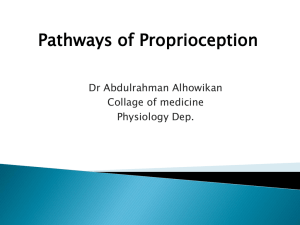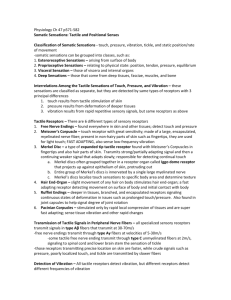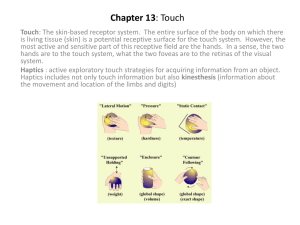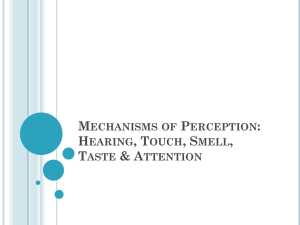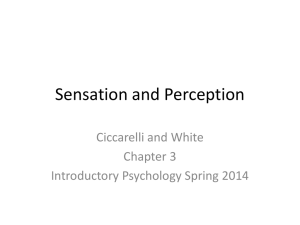phys chapter 47 [3-6
advertisement
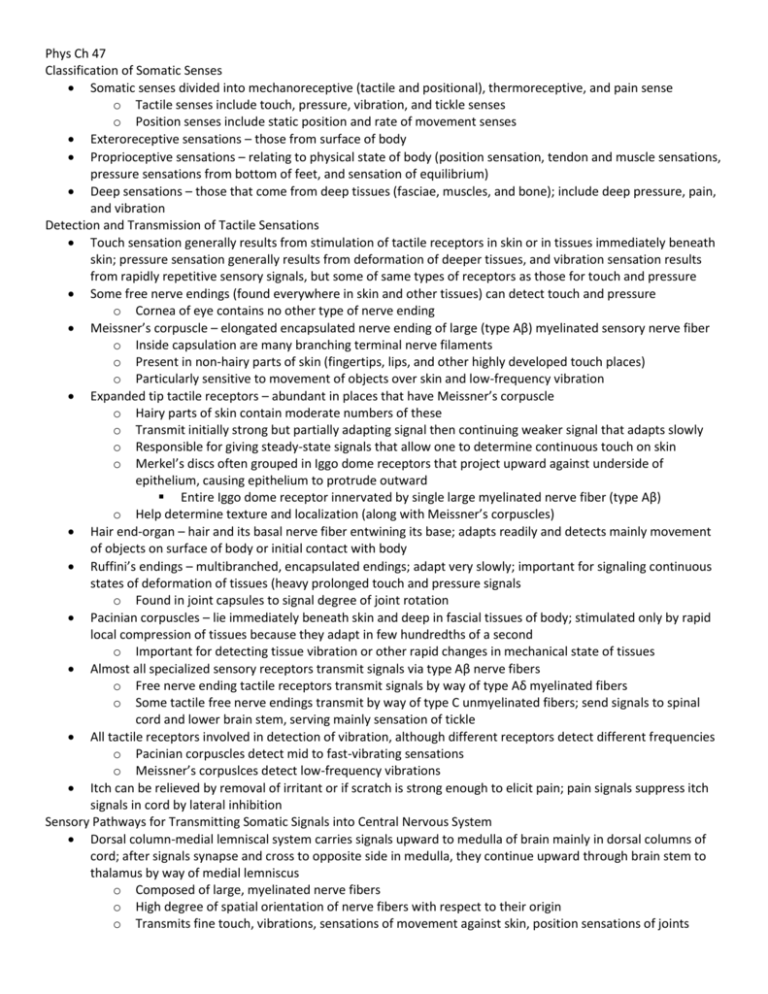
Phys Ch 47 Classification of Somatic Senses Somatic senses divided into mechanoreceptive (tactile and positional), thermoreceptive, and pain sense o Tactile senses include touch, pressure, vibration, and tickle senses o Position senses include static position and rate of movement senses Exteroreceptive sensations – those from surface of body Proprioceptive sensations – relating to physical state of body (position sensation, tendon and muscle sensations, pressure sensations from bottom of feet, and sensation of equilibrium) Deep sensations – those that come from deep tissues (fasciae, muscles, and bone); include deep pressure, pain, and vibration Detection and Transmission of Tactile Sensations Touch sensation generally results from stimulation of tactile receptors in skin or in tissues immediately beneath skin; pressure sensation generally results from deformation of deeper tissues, and vibration sensation results from rapidly repetitive sensory signals, but some of same types of receptors as those for touch and pressure Some free nerve endings (found everywhere in skin and other tissues) can detect touch and pressure o Cornea of eye contains no other type of nerve ending Meissner’s corpuscle – elongated encapsulated nerve ending of large (type Aβ) myelinated sensory nerve fiber o Inside capsulation are many branching terminal nerve filaments o Present in non-hairy parts of skin (fingertips, lips, and other highly developed touch places) o Particularly sensitive to movement of objects over skin and low-frequency vibration Expanded tip tactile receptors – abundant in places that have Meissner’s corpuscle o Hairy parts of skin contain moderate numbers of these o Transmit initially strong but partially adapting signal then continuing weaker signal that adapts slowly o Responsible for giving steady-state signals that allow one to determine continuous touch on skin o Merkel’s discs often grouped in Iggo dome receptors that project upward against underside of epithelium, causing epithelium to protrude outward Entire Iggo dome receptor innervated by single large myelinated nerve fiber (type Aβ) o Help determine texture and localization (along with Meissner’s corpuscles) Hair end-organ – hair and its basal nerve fiber entwining its base; adapts readily and detects mainly movement of objects on surface of body or initial contact with body Ruffini’s endings – multibranched, encapsulated endings; adapt very slowly; important for signaling continuous states of deformation of tissues (heavy prolonged touch and pressure signals o Found in joint capsules to signal degree of joint rotation Pacinian corpuscles – lie immediately beneath skin and deep in fascial tissues of body; stimulated only by rapid local compression of tissues because they adapt in few hundredths of a second o Important for detecting tissue vibration or other rapid changes in mechanical state of tissues Almost all specialized sensory receptors transmit signals via type Aβ nerve fibers o Free nerve ending tactile receptors transmit signals by way of type Aδ myelinated fibers o Some tactile free nerve endings transmit by way of type C unmyelinated fibers; send signals to spinal cord and lower brain stem, serving mainly sensation of tickle All tactile receptors involved in detection of vibration, although different receptors detect different frequencies o Pacinian corpuscles detect mid to fast-vibrating sensations o Meissner’s corpuslces detect low-frequency vibrations Itch can be relieved by removal of irritant or if scratch is strong enough to elicit pain; pain signals suppress itch signals in cord by lateral inhibition Sensory Pathways for Transmitting Somatic Signals into Central Nervous System Dorsal column-medial lemniscal system carries signals upward to medulla of brain mainly in dorsal columns of cord; after signals synapse and cross to opposite side in medulla, they continue upward through brain stem to thalamus by way of medial lemniscus o Composed of large, myelinated nerve fibers o High degree of spatial orientation of nerve fibers with respect to their origin o Transmits fine touch, vibrations, sensations of movement against skin, position sensations of joints Anterolateral system synapses in dorsal horns of spinal gray matter then cross to opposite side of cord and ascend through anterior and lateral white columns of cord o Terminate at all levels of lower brain stem and thalamus o Composed of smaller myelinated fibers o Much less spatial orientation o Transmits pain, temperature, tickle and itch, sexual sensations, and crude tactile sensations Transmission in Dorsal Column-Medial Lemniscal System On entering spinal cord through dorsal roots, large myelinated fibers divide almost immediately to form medial branch and lateral branch; medial branch turns medially first then upward in dorsal column, going up dorsal column pathway to brain; lateral branch enters dorsal horn of cord gray matter, then divides many times to provide terminals that synapse with local neurons in intermediate and anterior portions of cord gray matter Local neurons from lateral branch either give off fibers that enter dorsal columns of cord and travel upward to brain (most), terminate locally in spinal cord gray matter to elicit local spinal cord reflexes, or give rise to spinocerebellar tracts Nerve fibers entering dorsal columns pass uninterrupted up to dorsal medulla, where they synapse in dorsal column nuclei (cuneate and gracile nuclei); from there, second-order neurons decussate immediately to opposite side of brain stem and continue upward through medial lemnisci to thalamus o In pathway through brainstem, each medial lemniscus joined by additional fibers from sensory nuclei of trigeminal nerve; fibers subserve same sensory functions for head as dorsal column fibers serve for body o In thalamus, medial lemniscal fibers terminate in thalamic sensory relay area (ventrobasal complex) o From ventrobasal complex, third-order nerve fibers project mainly to postcentral gyrus of cerebral cortex (somatic sensory area I); fibers also project to smaller area in lateral parietal cortex (somatic sensory area II) Distinct spatial orientation of nerve fibers maintained throughout (fibers from lower parts of body lie toward center of cord, whereas those that enter cord higher form successive layers laterally In thalamus, tail end of body is most lateral portions of ventrobasal complex and head and face in medial areas of complex Because it crosses in medulla, left side of body represented in right side of thalamus Brodmann’s areas based on histological structural differences In general, sensory signals from all modalities of sensation terminate in cerebral cortex immediately posterior to central fissure Generally, anterior half of parietal lobe concerned almost entirely with reception and interpretation of somatosensory signals; posterior half of parietal lobe provides still higher levels of interpretation Visual signals terminate in occipital lobe Auditory signals terminate in temporal lobe Portion of cerebral cortex anterior to central fissure (posterior half of frontal lobe) is motor cortex; major share of motor control in response to somatosensory signals received from sensory portions of cortex, which keep motor cortex informed at each instant about positions and motions of different body parts Somatosensory area I has high degree of localization of different parts of body Localization poor in somatosensory area II; face represented anteriorly, arms centrally, and legs posteriorly o Signals enter this area from brainstem, transmitter upward from both sides of body o Many signals come secondarily from somatosensory area I, as well as from other sensory areas of brain o Projections from somatosensory area I required for function of area II o Removal of parts of somatosensory area II has no apparent effect on response of neurons in somatosensory area I Cerebral cortex contains 6 layers of neurons (layer I next to brain surface; layer VI deepest) o Incoming sensory signal excites neuronal layer IV first; then signal spreads toward surface of cortex and toward deeper layers o Layers I and II receive diffuse, nonspecific input signals from lower brain centers that facilitate specific regions of cortex; input mainly controls overall level of excitability of respective regions stimulated o Neurons in layers II and III send axons to related portions of cerebral cortex on opposite side of brain through corpus callosum o Neurons in layers V and VI send axons to deeper parts of nervous system Those in layer V generally larger and project to more distant areas (basal ganglia, brainstem, spinal cord), where they control signal transmission From layer VI, especially large numbers of axons extend to thalamus, providing signals from cerebral cortex that interact with and help to control excitatory levels of incoming sensory signals entering thalamus Neurons of somatosensory cortex arranged in vertical columns extending all the way through 6 layers of cortex o Each column serves single specific sensory modality (responding to stretch receptors or tactile hairs) o At layer IV, where input sensory signals first enter cortex, columns of neurons function almost entirely separately from one another o Interactions occur at other levels that initiate analysis of meanings of sensory signals In most anterior 5-10 mm of postcentral gyrus, large share of vertical columns respond to muscle, tendon, and joint stretch receptors o Many signals from these columns spread anteriorly, directly to motor cortex located immediately forward of central fissure o Signals play role in controlling effluent motor signals that activate sequences of muscle contraction As you move posteriorly in somatosensory area I, more and more vertical columns respond to slowly adapting cutaneous receptors, and still farther posteriorly, greater numbers of columns sensitive to deep pressure In most posterior portion of somatosensory area I, 6% of vertical columns respond only when stimulus moves across skin in particular direction (higher order interpretation of sensory signals) Without somatosensory area, unable to localize discretely different sensations in different parts of body (can localize sensations crudely as particular hand to major level of body trunk), unable to judge critical degrees of pressure against body, unable to judge weights of objects, unable to judge shapes or forms of objects (astereognosis), unable to judge texture of materials because this depends on highly critical sensations caused by movement of fingers over surface to be judged Pain and temp localization depend greatly on topographical map of body in somatosensory area I, but sensations themselves are felt without it Parietal cortex behind somatosensory area I decipher deeper meanings of sensory info (somatosensory association areas) o Electrical stimulation of this area can cause awake person to experience complex body sensation, sometimes even feeling of a particular object o Combines info arriving from multiple points in primary somatosensory area to decipher meaning o Receives signals from somatosensory area I, ventrobasal nuclei of thalamus, other areas of thalamus, visual cortex, and auditory cortex When somatosensory association area removed on one side of brain, person loses ability to recognize complex objects and complex forms felt on opposite side of body o Lose most of sense of form of body or parts on opposite side (hemineglect) o When feeling objects, person tends to recognize only one side of object and forgets other side exists (amorphosynthesis) At each synaptic stage, divergence occurs Reason for difference in 2 point discrimination in different parts of body due to different numbers of specialized tactile receptors in different areas o Capability of sensorium to distinguish presence of 2 points strongly influenced by lateral inhibition Lateral inhibitory signals occur at each synaptic level; peaks of excitation stand out, and much of surrounding diffuse stimulation blocked Vibration only transmitted in dorsal column pathway Proprioceptive senses can be static position sense or rate of movement sense (kinesthesia or dynamic proprioception) o Both skin tactile receptors and deep receptors near joints used; for most of larger joints of body, deep receptors more important o For determining joint angulation, most important receptors are muscle spindles o At extremes of joint angulation, stretch of ligaments and deep tissues around joints determine position Pacinian corpuscles, Ruffini’s endings, and receptors similar to Golgi tendon receptors o Thalamic neurons responding to joint rotation include those maximally stimulated when joint at full rotation and those maximally stimulated when joint is at minimal rotation Interpretation of Sensory Stimulus Intensity When sound stimulates specific point on basilar membrane, weak sound stimulates only those hair cells at point of max sound vibration; as sound intensity increases, many more hair cells in each direction farther away from max vibratory point become stimulated o Signals transmitted over progressively increasing numbers of nerve fibers Gradations of stimulus strength discriminated approximately in proportion to log of stimulus strength; ratio of change in stimulus strength required for detection remains essentially constant (1:30) o Above is Weber-Fechner principle; applies only to higher intensities of visual, auditory, and cutaneous sensory expierence o Greater background sensory intensity, greater additional change must be to detect change Transmission of Less Critical Sensory Signals in Anterolateral Pathway Transmits sensory signals that don’t require highly discrete localization Anterolateral fibers cross immediately in anterior commissure of cord to opposite anterior and lateral white columns, where they turn upward toward brain via anterior spinothalamic and lateral spinothalamic tracts Upper terminus of 2 spinothalamic tracts is throughout reticular nuclei of brain stem and in 2 different nuclear complexes of thalamus (ventrobasal complex and intralaminar nuclei) Tactile signals transmitted mainly into ventrobasal complex, terminating in some of same thalamic nuclei where dorsal column tactile signals terminate; from here, signals transmitted to somatosensory cortex along with signals from dorsal columns Only small fraction of pain signals project directly to ventrobasal complex of thalamus; most pain signals terminate in reticular nuclei of brain stem and are relayed from there to intralaminar nuclei of thalamus where pain signals further processed Some Special Aspects of Somatosensory Function Thalamus (or other lower centers) has slight ability to discriminate tactile sensation, even though thalamus normally functions to relay info to cortex; slight degree of crude tactile sensibility returns after somatosensory cortex destroyed Loss of somatosensory cortex has little effect on one’s perception of pain sensation and only moderate effect on perception of temp; lower brain stem, thalamus, and associated basal regions of brain play dominant roles in discrimination of these Corticofugal signals transmitted in backwards direction from cerebral cortex to lower sensory relay stations of thalamus, medulla, and spinal cord; control intensity of sensitivity of sensory input o Almost entirely inhibitory; when sensory input intensity becomes too great, corticofugal signals automatically decrease transmission in relay nuclei o Decreases lateral spread of sensory signals into adjacent neurons and therefore increases degree of sharpness in signal pattern o Keeps sensory system operating in range of sensitivity not so low that signals ineffectual nor so high system swamped beyond capacity to differentiate sensory patterns
